BIOL40108: Introductory Biology Assessment 3, Term 3, 2018
VerifiedAdded on 2022/08/13
|16
|3681
|16
Homework Assignment
AI Summary
This document contains the solutions for BIOL40108 Assessment 3, an open-book assignment from Term 3, 2018, covering introductory biology concepts. The assignment includes short answer questions differentiating between terms like animal and plant cells, ectoderm and endoderm, metaphase and anaphase, cellulose and glycogen, and transcription and translation. It also presents genetics questions related to blood types, Punnett squares, genotypes, and phenotypes. The assessment further explores topics like osmosis, the sodium-potassium pump, and DNA sequences, along with questions identifying cellular organelles such as mitochondria, the nuclear membrane, smooth endoplasmic reticulum, villi, and centrioles. The answers provided offer concise explanations and detailed differentiations to help students understand key biological principles.
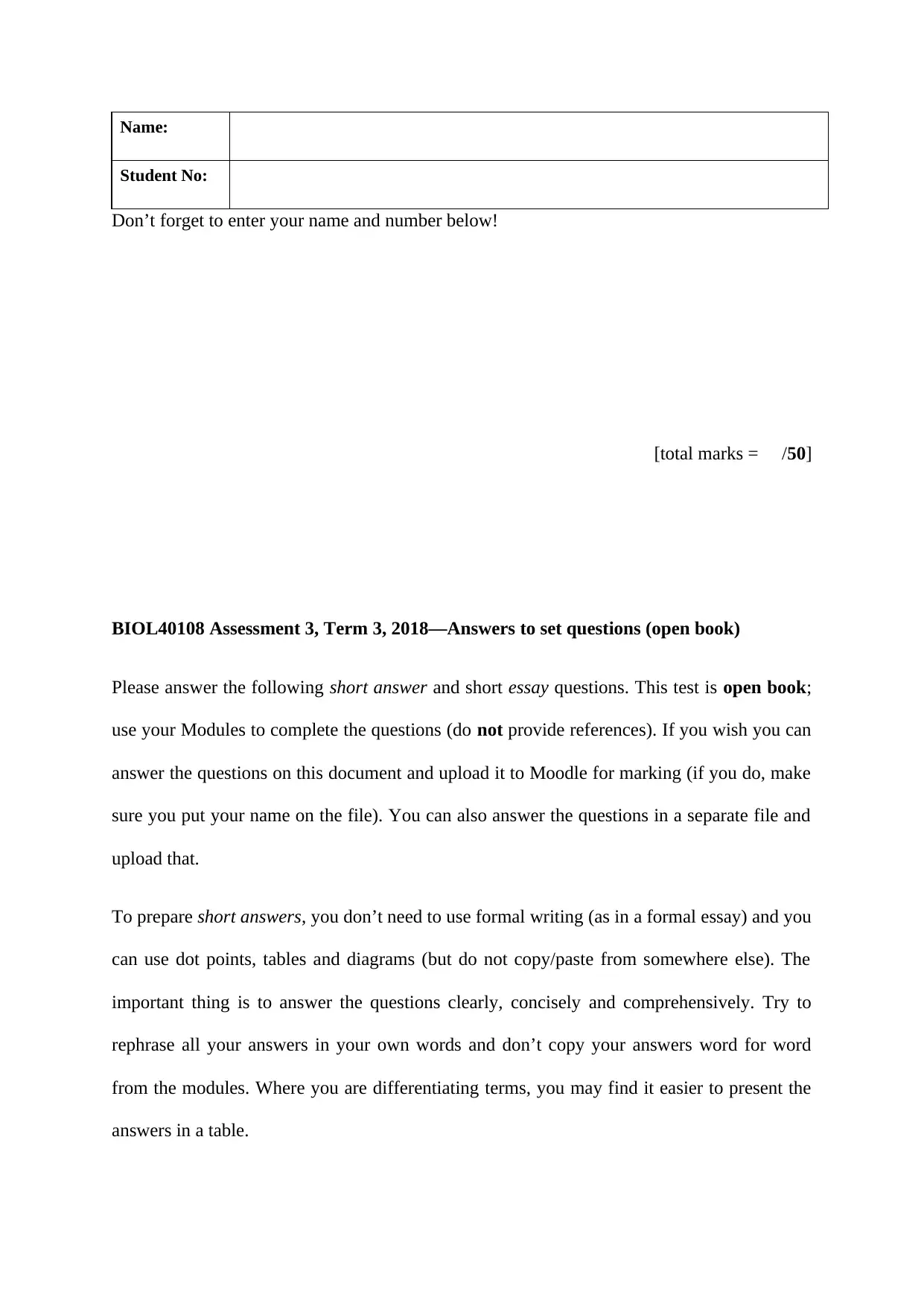
Name:
Student No:
Don’t forget to enter your name and number below!
[total marks = /50]
BIOL40108 Assessment 3, Term 3, 2018—Answers to set questions (open book)
Please answer the following short answer and short essay questions. This test is open book;
use your Modules to complete the questions (do not provide references). If you wish you can
answer the questions on this document and upload it to Moodle for marking (if you do, make
sure you put your name on the file). You can also answer the questions in a separate file and
upload that.
To prepare short answers, you don’t need to use formal writing (as in a formal essay) and you
can use dot points, tables and diagrams (but do not copy/paste from somewhere else). The
important thing is to answer the questions clearly, concisely and comprehensively. Try to
rephrase all your answers in your own words and don’t copy your answers word for word
from the modules. Where you are differentiating terms, you may find it easier to present the
answers in a table.
Student No:
Don’t forget to enter your name and number below!
[total marks = /50]
BIOL40108 Assessment 3, Term 3, 2018—Answers to set questions (open book)
Please answer the following short answer and short essay questions. This test is open book;
use your Modules to complete the questions (do not provide references). If you wish you can
answer the questions on this document and upload it to Moodle for marking (if you do, make
sure you put your name on the file). You can also answer the questions in a separate file and
upload that.
To prepare short answers, you don’t need to use formal writing (as in a formal essay) and you
can use dot points, tables and diagrams (but do not copy/paste from somewhere else). The
important thing is to answer the questions clearly, concisely and comprehensively. Try to
rephrase all your answers in your own words and don’t copy your answers word for word
from the modules. Where you are differentiating terms, you may find it easier to present the
answers in a table.
Paraphrase This Document
Need a fresh take? Get an instant paraphrase of this document with our AI Paraphraser
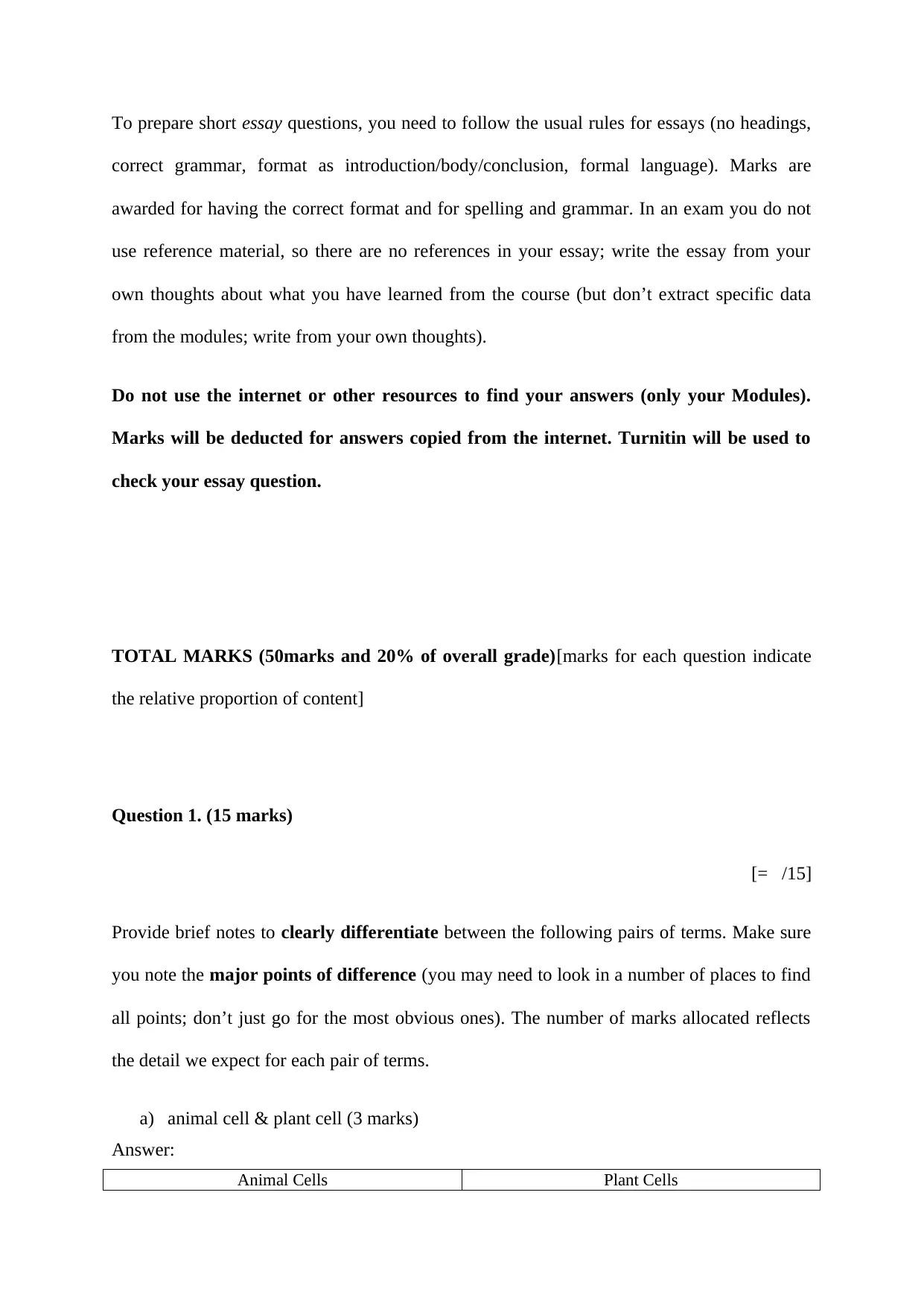
To prepare short essay questions, you need to follow the usual rules for essays (no headings,
correct grammar, format as introduction/body/conclusion, formal language). Marks are
awarded for having the correct format and for spelling and grammar. In an exam you do not
use reference material, so there are no references in your essay; write the essay from your
own thoughts about what you have learned from the course (but don’t extract specific data
from the modules; write from your own thoughts).
Do not use the internet or other resources to find your answers (only your Modules).
Marks will be deducted for answers copied from the internet. Turnitin will be used to
check your essay question.
TOTAL MARKS (50marks and 20% of overall grade)[marks for each question indicate
the relative proportion of content]
Question 1. (15 marks)
[= /15]
Provide brief notes to clearly differentiate between the following pairs of terms. Make sure
you note the major points of difference (you may need to look in a number of places to find
all points; don’t just go for the most obvious ones). The number of marks allocated reflects
the detail we expect for each pair of terms.
a) animal cell & plant cell (3 marks)
Answer:
Animal Cells Plant Cells
correct grammar, format as introduction/body/conclusion, formal language). Marks are
awarded for having the correct format and for spelling and grammar. In an exam you do not
use reference material, so there are no references in your essay; write the essay from your
own thoughts about what you have learned from the course (but don’t extract specific data
from the modules; write from your own thoughts).
Do not use the internet or other resources to find your answers (only your Modules).
Marks will be deducted for answers copied from the internet. Turnitin will be used to
check your essay question.
TOTAL MARKS (50marks and 20% of overall grade)[marks for each question indicate
the relative proportion of content]
Question 1. (15 marks)
[= /15]
Provide brief notes to clearly differentiate between the following pairs of terms. Make sure
you note the major points of difference (you may need to look in a number of places to find
all points; don’t just go for the most obvious ones). The number of marks allocated reflects
the detail we expect for each pair of terms.
a) animal cell & plant cell (3 marks)
Answer:
Animal Cells Plant Cells
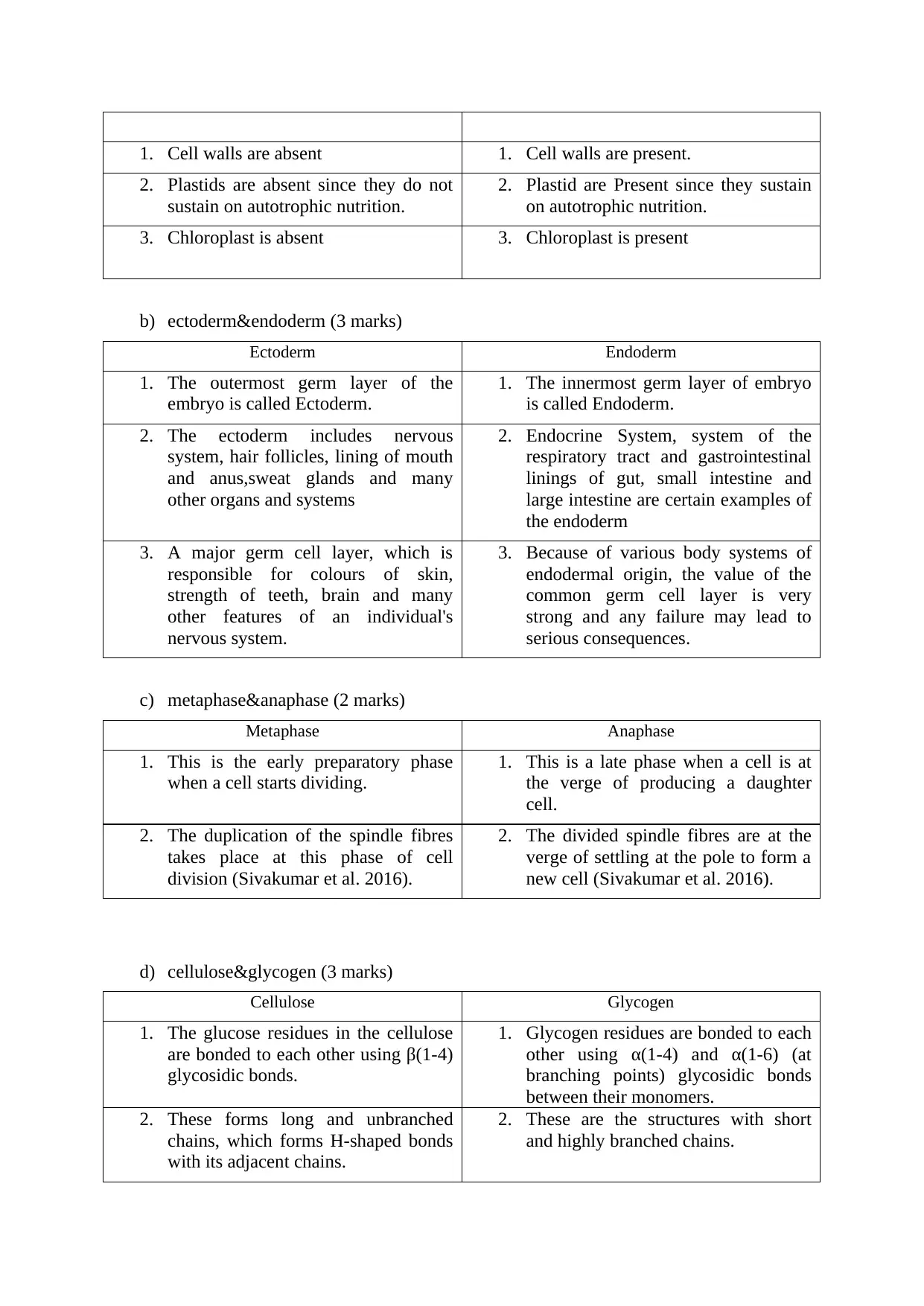
1. Cell walls are absent 1. Cell walls are present.
2. Plastids are absent since they do not
sustain on autotrophic nutrition.
2. Plastid are Present since they sustain
on autotrophic nutrition.
3. Chloroplast is absent 3. Chloroplast is present
b) ectoderm&endoderm (3 marks)
Ectoderm Endoderm
1. The outermost germ layer of the
embryo is called Ectoderm.
1. The innermost germ layer of embryo
is called Endoderm.
2. The ectoderm includes nervous
system, hair follicles, lining of mouth
and anus,sweat glands and many
other organs and systems
2. Endocrine System, system of the
respiratory tract and gastrointestinal
linings of gut, small intestine and
large intestine are certain examples of
the endoderm
3. A major germ cell layer, which is
responsible for colours of skin,
strength of teeth, brain and many
other features of an individual's
nervous system.
3. Because of various body systems of
endodermal origin, the value of the
common germ cell layer is very
strong and any failure may lead to
serious consequences.
c) metaphase&anaphase (2 marks)
Metaphase Anaphase
1. This is the early preparatory phase
when a cell starts dividing.
1. This is a late phase when a cell is at
the verge of producing a daughter
cell.
2. The duplication of the spindle fibres
takes place at this phase of cell
division (Sivakumar et al. 2016).
2. The divided spindle fibres are at the
verge of settling at the pole to form a
new cell (Sivakumar et al. 2016).
d) cellulose&glycogen (3 marks)
Cellulose Glycogen
1. The glucose residues in the cellulose
are bonded to each other using β(1-4)
glycosidic bonds.
1. Glycogen residues are bonded to each
other using α(1-4) and α(1-6) (at
branching points) glycosidic bonds
between their monomers.
2. These forms long and unbranched
chains, which forms H-shaped bonds
with its adjacent chains.
2. These are the structures with short
and highly branched chains.
2. Plastids are absent since they do not
sustain on autotrophic nutrition.
2. Plastid are Present since they sustain
on autotrophic nutrition.
3. Chloroplast is absent 3. Chloroplast is present
b) ectoderm&endoderm (3 marks)
Ectoderm Endoderm
1. The outermost germ layer of the
embryo is called Ectoderm.
1. The innermost germ layer of embryo
is called Endoderm.
2. The ectoderm includes nervous
system, hair follicles, lining of mouth
and anus,sweat glands and many
other organs and systems
2. Endocrine System, system of the
respiratory tract and gastrointestinal
linings of gut, small intestine and
large intestine are certain examples of
the endoderm
3. A major germ cell layer, which is
responsible for colours of skin,
strength of teeth, brain and many
other features of an individual's
nervous system.
3. Because of various body systems of
endodermal origin, the value of the
common germ cell layer is very
strong and any failure may lead to
serious consequences.
c) metaphase&anaphase (2 marks)
Metaphase Anaphase
1. This is the early preparatory phase
when a cell starts dividing.
1. This is a late phase when a cell is at
the verge of producing a daughter
cell.
2. The duplication of the spindle fibres
takes place at this phase of cell
division (Sivakumar et al. 2016).
2. The divided spindle fibres are at the
verge of settling at the pole to form a
new cell (Sivakumar et al. 2016).
d) cellulose&glycogen (3 marks)
Cellulose Glycogen
1. The glucose residues in the cellulose
are bonded to each other using β(1-4)
glycosidic bonds.
1. Glycogen residues are bonded to each
other using α(1-4) and α(1-6) (at
branching points) glycosidic bonds
between their monomers.
2. These forms long and unbranched
chains, which forms H-shaped bonds
with its adjacent chains.
2. These are the structures with short
and highly branched chains.
⊘ This is a preview!⊘
Do you want full access?
Subscribe today to unlock all pages.

Trusted by 1+ million students worldwide
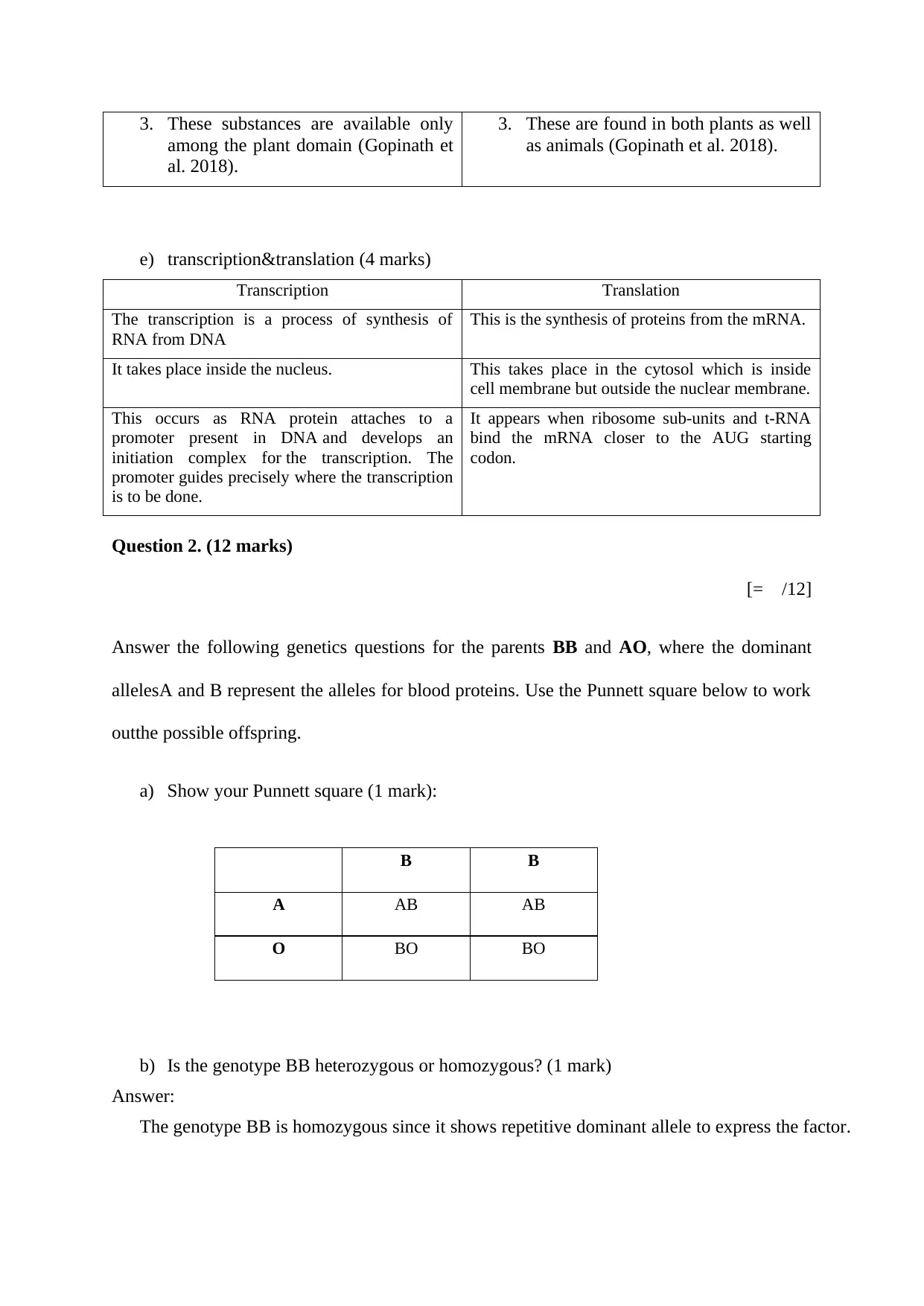
3. These substances are available only
among the plant domain (Gopinath et
al. 2018).
3. These are found in both plants as well
as animals (Gopinath et al. 2018).
e) transcription&translation (4 marks)
Transcription Translation
The transcription is a process of synthesis of
RNA from DNA
This is the synthesis of proteins from the mRNA.
It takes place inside the nucleus. This takes place in the cytosol which is inside
cell membrane but outside the nuclear membrane.
This occurs as RNA protein attaches to a
promoter present in DNA and develops an
initiation complex for the transcription. The
promoter guides precisely where the transcription
is to be done.
It appears when ribosome sub-units and t-RNA
bind the mRNA closer to the AUG starting
codon.
Question 2. (12 marks)
[= /12]
Answer the following genetics questions for the parents BB and AO, where the dominant
allelesA and B represent the alleles for blood proteins. Use the Punnett square below to work
outthe possible offspring.
a) Show your Punnett square (1 mark):
B B
A AB AB
O BO BO
b) Is the genotype BB heterozygous or homozygous? (1 mark)
Answer:
The genotype BB is homozygous since it shows repetitive dominant allele to express the factor.
among the plant domain (Gopinath et
al. 2018).
3. These are found in both plants as well
as animals (Gopinath et al. 2018).
e) transcription&translation (4 marks)
Transcription Translation
The transcription is a process of synthesis of
RNA from DNA
This is the synthesis of proteins from the mRNA.
It takes place inside the nucleus. This takes place in the cytosol which is inside
cell membrane but outside the nuclear membrane.
This occurs as RNA protein attaches to a
promoter present in DNA and develops an
initiation complex for the transcription. The
promoter guides precisely where the transcription
is to be done.
It appears when ribosome sub-units and t-RNA
bind the mRNA closer to the AUG starting
codon.
Question 2. (12 marks)
[= /12]
Answer the following genetics questions for the parents BB and AO, where the dominant
allelesA and B represent the alleles for blood proteins. Use the Punnett square below to work
outthe possible offspring.
a) Show your Punnett square (1 mark):
B B
A AB AB
O BO BO
b) Is the genotype BB heterozygous or homozygous? (1 mark)
Answer:
The genotype BB is homozygous since it shows repetitive dominant allele to express the factor.
Paraphrase This Document
Need a fresh take? Get an instant paraphrase of this document with our AI Paraphraser
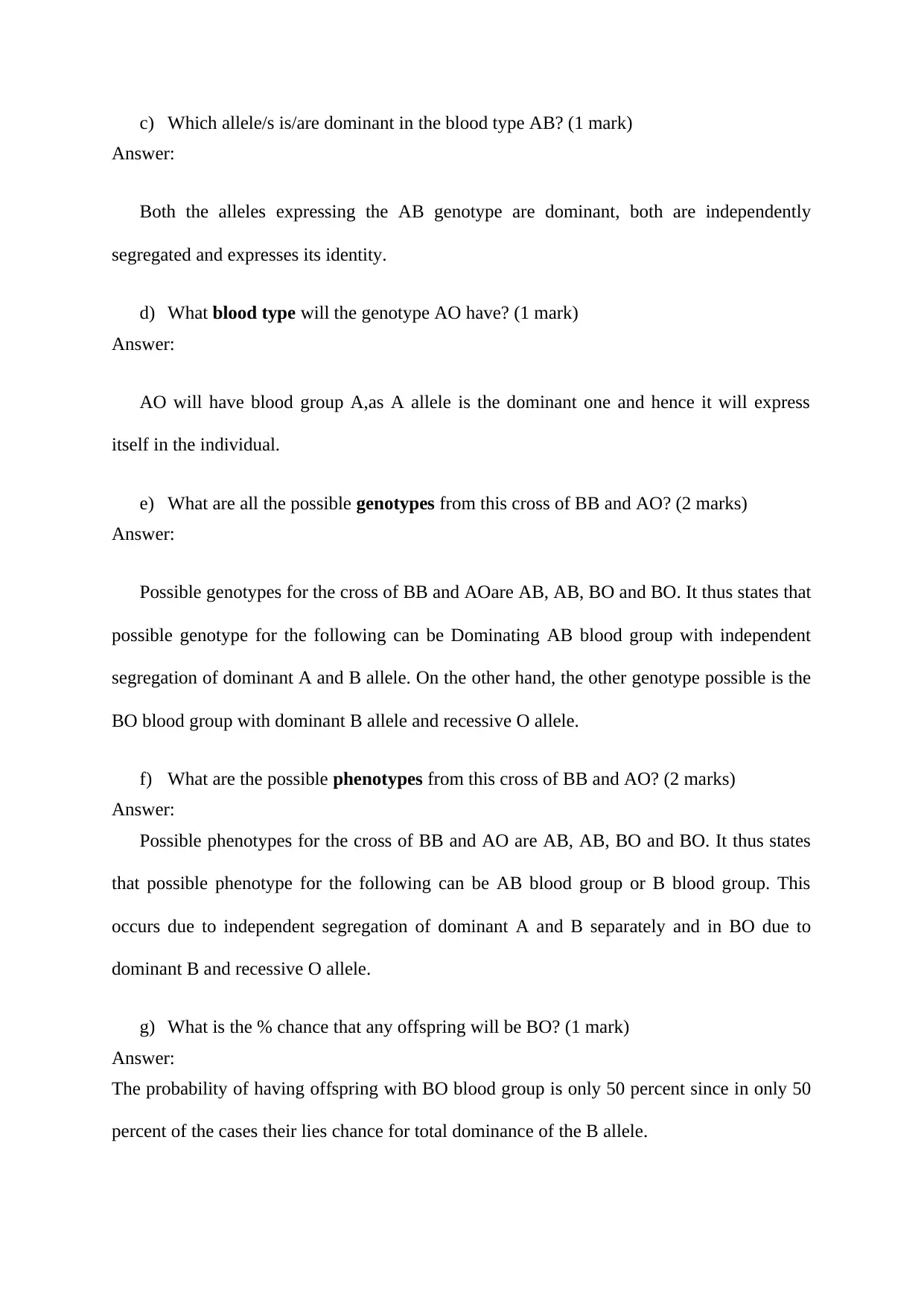
c) Which allele/s is/are dominant in the blood type AB? (1 mark)
Answer:
Both the alleles expressing the AB genotype are dominant, both are independently
segregated and expresses its identity.
d) What blood type will the genotype AO have? (1 mark)
Answer:
AO will have blood group A,as A allele is the dominant one and hence it will express
itself in the individual.
e) What are all the possible genotypes from this cross of BB and AO? (2 marks)
Answer:
Possible genotypes for the cross of BB and AOare AB, AB, BO and BO. It thus states that
possible genotype for the following can be Dominating AB blood group with independent
segregation of dominant A and B allele. On the other hand, the other genotype possible is the
BO blood group with dominant B allele and recessive O allele.
f) What are the possible phenotypes from this cross of BB and AO? (2 marks)
Answer:
Possible phenotypes for the cross of BB and AO are AB, AB, BO and BO. It thus states
that possible phenotype for the following can be AB blood group or B blood group. This
occurs due to independent segregation of dominant A and B separately and in BO due to
dominant B and recessive O allele.
g) What is the % chance that any offspring will be BO? (1 mark)
Answer:
The probability of having offspring with BO blood group is only 50 percent since in only 50
percent of the cases their lies chance for total dominance of the B allele.
Answer:
Both the alleles expressing the AB genotype are dominant, both are independently
segregated and expresses its identity.
d) What blood type will the genotype AO have? (1 mark)
Answer:
AO will have blood group A,as A allele is the dominant one and hence it will express
itself in the individual.
e) What are all the possible genotypes from this cross of BB and AO? (2 marks)
Answer:
Possible genotypes for the cross of BB and AOare AB, AB, BO and BO. It thus states that
possible genotype for the following can be Dominating AB blood group with independent
segregation of dominant A and B allele. On the other hand, the other genotype possible is the
BO blood group with dominant B allele and recessive O allele.
f) What are the possible phenotypes from this cross of BB and AO? (2 marks)
Answer:
Possible phenotypes for the cross of BB and AO are AB, AB, BO and BO. It thus states
that possible phenotype for the following can be AB blood group or B blood group. This
occurs due to independent segregation of dominant A and B separately and in BO due to
dominant B and recessive O allele.
g) What is the % chance that any offspring will be BO? (1 mark)
Answer:
The probability of having offspring with BO blood group is only 50 percent since in only 50
percent of the cases their lies chance for total dominance of the B allele.

⊘ This is a preview!⊘
Do you want full access?
Subscribe today to unlock all pages.

Trusted by 1+ million students worldwide
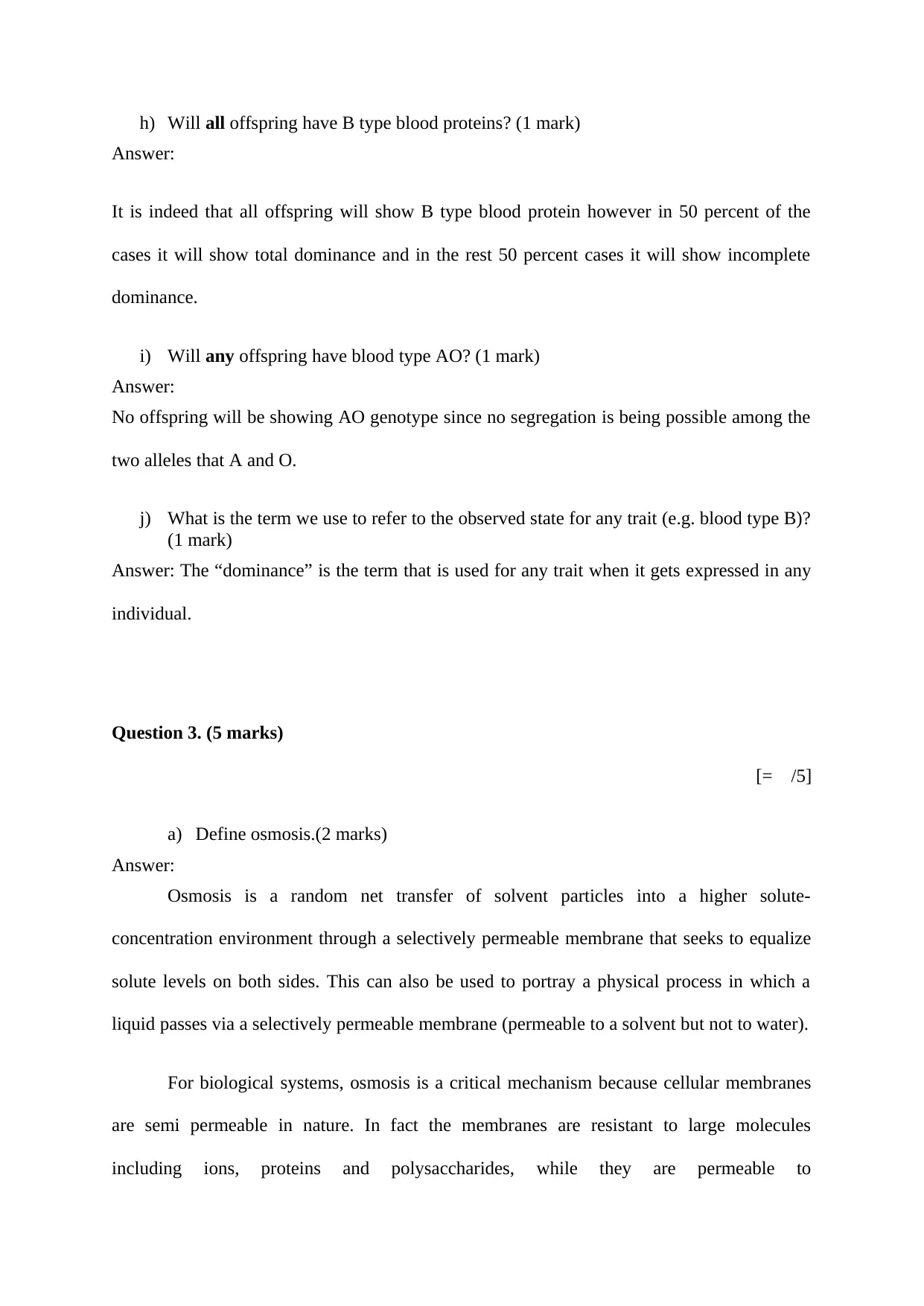
h) Will all offspring have B type blood proteins? (1 mark)
Answer:
It is indeed that all offspring will show B type blood protein however in 50 percent of the
cases it will show total dominance and in the rest 50 percent cases it will show incomplete
dominance.
i) Will any offspring have blood type AO? (1 mark)
Answer:
No offspring will be showing AO genotype since no segregation is being possible among the
two alleles that A and O.
j) What is the term we use to refer to the observed state for any trait (e.g. blood type B)?
(1 mark)
Answer: The “dominance” is the term that is used for any trait when it gets expressed in any
individual.
Question 3. (5 marks)
[= /5]
a) Define osmosis.(2 marks)
Answer:
Osmosis is a random net transfer of solvent particles into a higher solute-
concentration environment through a selectively permeable membrane that seeks to equalize
solute levels on both sides. This can also be used to portray a physical process in which a
liquid passes via a selectively permeable membrane (permeable to a solvent but not to water).
For biological systems, osmosis is a critical mechanism because cellular membranes
are semi permeable in nature. In fact the membranes are resistant to large molecules
including ions, proteins and polysaccharides, while they are permeable to
Answer:
It is indeed that all offspring will show B type blood protein however in 50 percent of the
cases it will show total dominance and in the rest 50 percent cases it will show incomplete
dominance.
i) Will any offspring have blood type AO? (1 mark)
Answer:
No offspring will be showing AO genotype since no segregation is being possible among the
two alleles that A and O.
j) What is the term we use to refer to the observed state for any trait (e.g. blood type B)?
(1 mark)
Answer: The “dominance” is the term that is used for any trait when it gets expressed in any
individual.
Question 3. (5 marks)
[= /5]
a) Define osmosis.(2 marks)
Answer:
Osmosis is a random net transfer of solvent particles into a higher solute-
concentration environment through a selectively permeable membrane that seeks to equalize
solute levels on both sides. This can also be used to portray a physical process in which a
liquid passes via a selectively permeable membrane (permeable to a solvent but not to water).
For biological systems, osmosis is a critical mechanism because cellular membranes
are semi permeable in nature. In fact the membranes are resistant to large molecules
including ions, proteins and polysaccharides, while they are permeable to
Paraphrase This Document
Need a fresh take? Get an instant paraphrase of this document with our AI Paraphraser
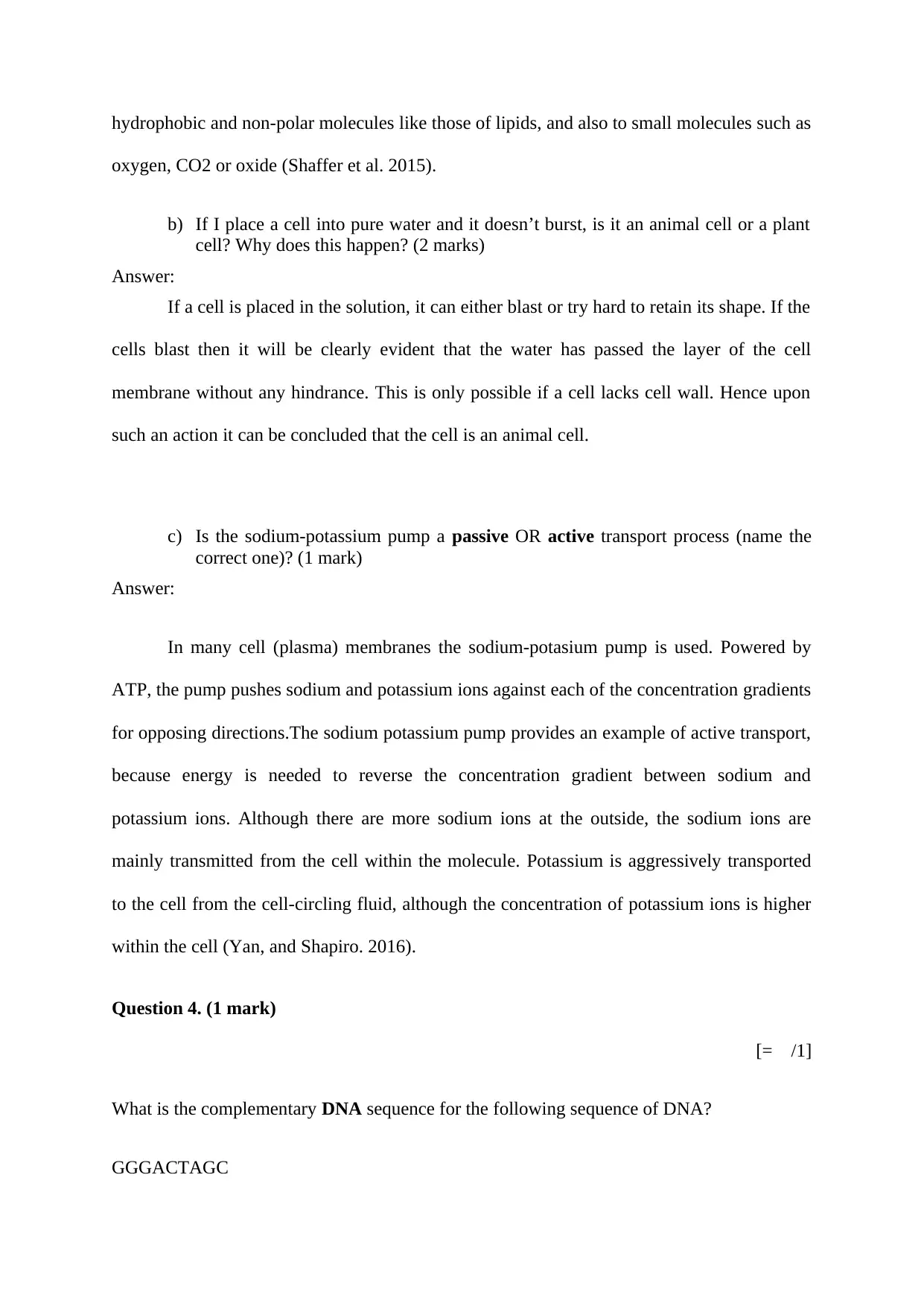
hydrophobic and non-polar molecules like those of lipids, and also to small molecules such as
oxygen, CO2 or oxide (Shaffer et al. 2015).
b) If I place a cell into pure water and it doesn’t burst, is it an animal cell or a plant
cell? Why does this happen? (2 marks)
Answer:
If a cell is placed in the solution, it can either blast or try hard to retain its shape. If the
cells blast then it will be clearly evident that the water has passed the layer of the cell
membrane without any hindrance. This is only possible if a cell lacks cell wall. Hence upon
such an action it can be concluded that the cell is an animal cell.
c) Is the sodium-potassium pump a passive OR active transport process (name the
correct one)? (1 mark)
Answer:
In many cell (plasma) membranes the sodium-potasium pump is used. Powered by
ATP, the pump pushes sodium and potassium ions against each of the concentration gradients
for opposing directions.The sodium potassium pump provides an example of active transport,
because energy is needed to reverse the concentration gradient between sodium and
potassium ions. Although there are more sodium ions at the outside, the sodium ions are
mainly transmitted from the cell within the molecule. Potassium is aggressively transported
to the cell from the cell-circling fluid, although the concentration of potassium ions is higher
within the cell (Yan, and Shapiro. 2016).
Question 4. (1 mark)
[= /1]
What is the complementary DNA sequence for the following sequence of DNA?
GGGACTAGC
oxygen, CO2 or oxide (Shaffer et al. 2015).
b) If I place a cell into pure water and it doesn’t burst, is it an animal cell or a plant
cell? Why does this happen? (2 marks)
Answer:
If a cell is placed in the solution, it can either blast or try hard to retain its shape. If the
cells blast then it will be clearly evident that the water has passed the layer of the cell
membrane without any hindrance. This is only possible if a cell lacks cell wall. Hence upon
such an action it can be concluded that the cell is an animal cell.
c) Is the sodium-potassium pump a passive OR active transport process (name the
correct one)? (1 mark)
Answer:
In many cell (plasma) membranes the sodium-potasium pump is used. Powered by
ATP, the pump pushes sodium and potassium ions against each of the concentration gradients
for opposing directions.The sodium potassium pump provides an example of active transport,
because energy is needed to reverse the concentration gradient between sodium and
potassium ions. Although there are more sodium ions at the outside, the sodium ions are
mainly transmitted from the cell within the molecule. Potassium is aggressively transported
to the cell from the cell-circling fluid, although the concentration of potassium ions is higher
within the cell (Yan, and Shapiro. 2016).
Question 4. (1 mark)
[= /1]
What is the complementary DNA sequence for the following sequence of DNA?
GGGACTAGC
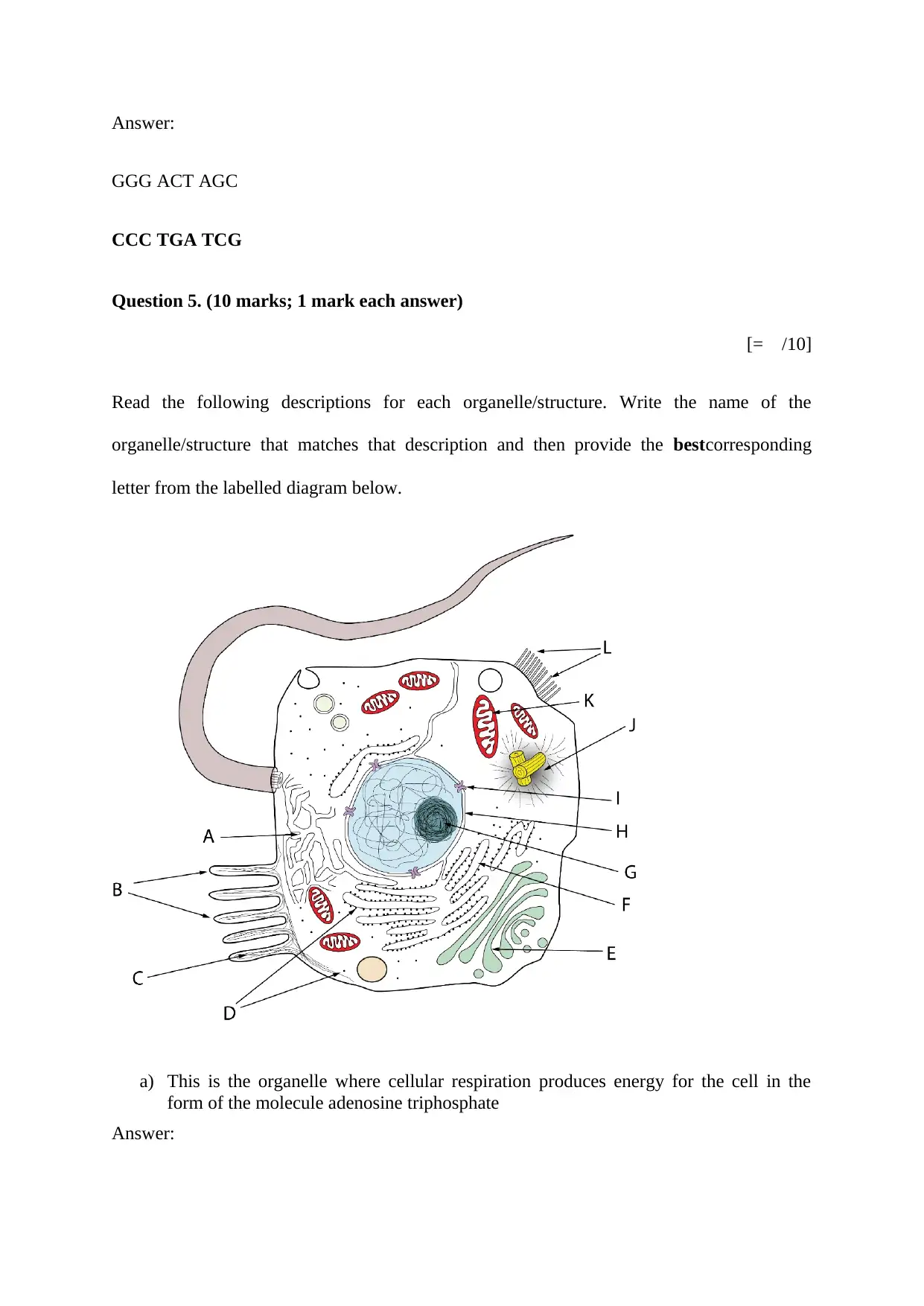
Answer:
GGG ACT AGC
CCC TGA TCG
Question 5. (10 marks; 1 mark each answer)
[= /10]
Read the following descriptions for each organelle/structure. Write the name of the
organelle/structure that matches that description and then provide the bestcorresponding
letter from the labelled diagram below.
a) This is the organelle where cellular respiration produces energy for the cell in the
form of the molecule adenosine triphosphate
Answer:
GGG ACT AGC
CCC TGA TCG
Question 5. (10 marks; 1 mark each answer)
[= /10]
Read the following descriptions for each organelle/structure. Write the name of the
organelle/structure that matches that description and then provide the bestcorresponding
letter from the labelled diagram below.
a) This is the organelle where cellular respiration produces energy for the cell in the
form of the molecule adenosine triphosphate
Answer:
⊘ This is a preview!⊘
Do you want full access?
Subscribe today to unlock all pages.

Trusted by 1+ million students worldwide
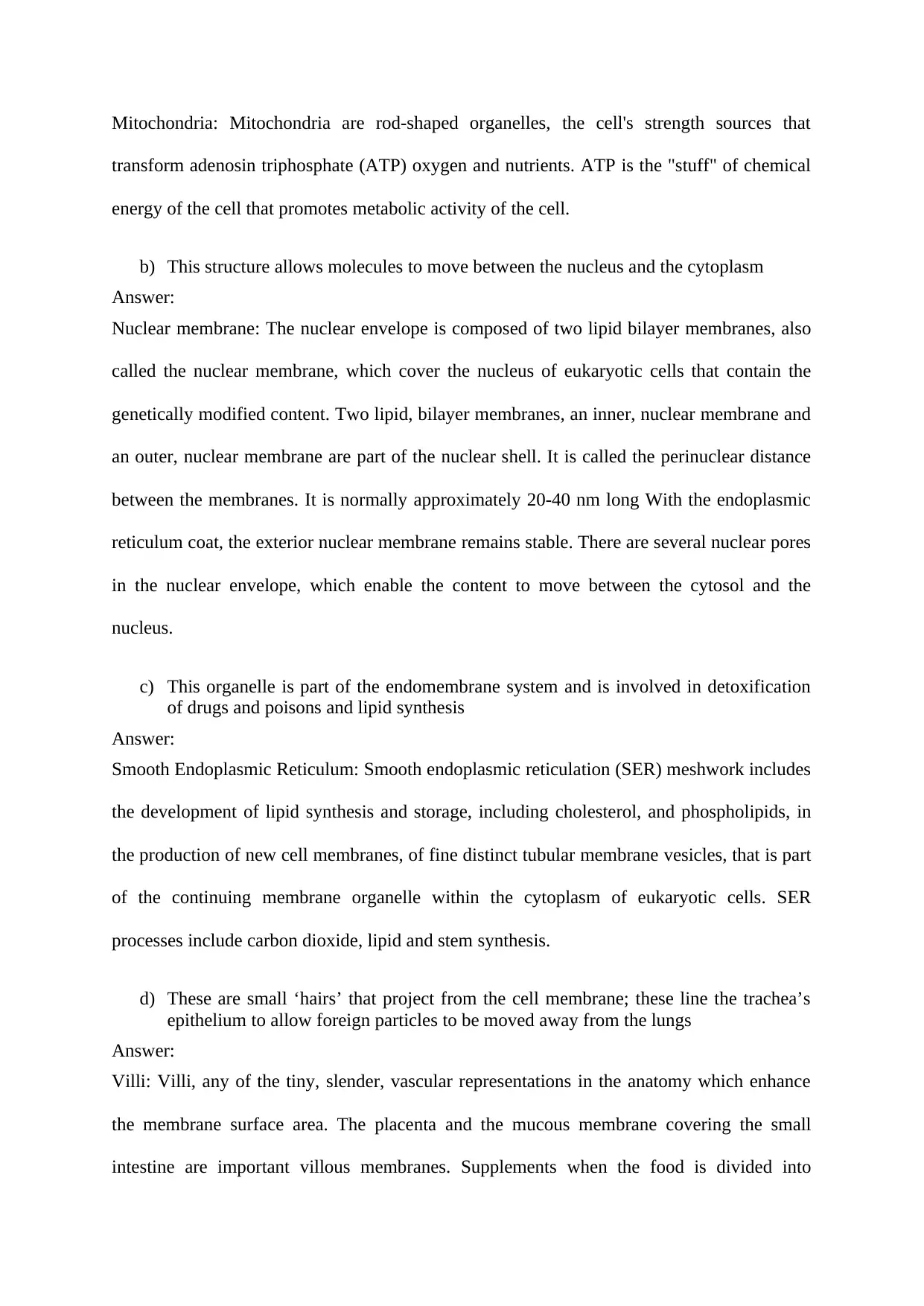
Mitochondria: Mitochondria are rod-shaped organelles, the cell's strength sources that
transform adenosin triphosphate (ATP) oxygen and nutrients. ATP is the "stuff" of chemical
energy of the cell that promotes metabolic activity of the cell.
b) This structure allows molecules to move between the nucleus and the cytoplasm
Answer:
Nuclear membrane: The nuclear envelope is composed of two lipid bilayer membranes, also
called the nuclear membrane, which cover the nucleus of eukaryotic cells that contain the
genetically modified content. Two lipid, bilayer membranes, an inner, nuclear membrane and
an outer, nuclear membrane are part of the nuclear shell. It is called the perinuclear distance
between the membranes. It is normally approximately 20-40 nm long With the endoplasmic
reticulum coat, the exterior nuclear membrane remains stable. There are several nuclear pores
in the nuclear envelope, which enable the content to move between the cytosol and the
nucleus.
c) This organelle is part of the endomembrane system and is involved in detoxification
of drugs and poisons and lipid synthesis
Answer:
Smooth Endoplasmic Reticulum: Smooth endoplasmic reticulation (SER) meshwork includes
the development of lipid synthesis and storage, including cholesterol, and phospholipids, in
the production of new cell membranes, of fine distinct tubular membrane vesicles, that is part
of the continuing membrane organelle within the cytoplasm of eukaryotic cells. SER
processes include carbon dioxide, lipid and stem synthesis.
d) These are small ‘hairs’ that project from the cell membrane; these line the trachea’s
epithelium to allow foreign particles to be moved away from the lungs
Answer:
Villi: Villi, any of the tiny, slender, vascular representations in the anatomy which enhance
the membrane surface area. The placenta and the mucous membrane covering the small
intestine are important villous membranes. Supplements when the food is divided into
transform adenosin triphosphate (ATP) oxygen and nutrients. ATP is the "stuff" of chemical
energy of the cell that promotes metabolic activity of the cell.
b) This structure allows molecules to move between the nucleus and the cytoplasm
Answer:
Nuclear membrane: The nuclear envelope is composed of two lipid bilayer membranes, also
called the nuclear membrane, which cover the nucleus of eukaryotic cells that contain the
genetically modified content. Two lipid, bilayer membranes, an inner, nuclear membrane and
an outer, nuclear membrane are part of the nuclear shell. It is called the perinuclear distance
between the membranes. It is normally approximately 20-40 nm long With the endoplasmic
reticulum coat, the exterior nuclear membrane remains stable. There are several nuclear pores
in the nuclear envelope, which enable the content to move between the cytosol and the
nucleus.
c) This organelle is part of the endomembrane system and is involved in detoxification
of drugs and poisons and lipid synthesis
Answer:
Smooth Endoplasmic Reticulum: Smooth endoplasmic reticulation (SER) meshwork includes
the development of lipid synthesis and storage, including cholesterol, and phospholipids, in
the production of new cell membranes, of fine distinct tubular membrane vesicles, that is part
of the continuing membrane organelle within the cytoplasm of eukaryotic cells. SER
processes include carbon dioxide, lipid and stem synthesis.
d) These are small ‘hairs’ that project from the cell membrane; these line the trachea’s
epithelium to allow foreign particles to be moved away from the lungs
Answer:
Villi: Villi, any of the tiny, slender, vascular representations in the anatomy which enhance
the membrane surface area. The placenta and the mucous membrane covering the small
intestine are important villous membranes. Supplements when the food is divided into
Paraphrase This Document
Need a fresh take? Get an instant paraphrase of this document with our AI Paraphraser
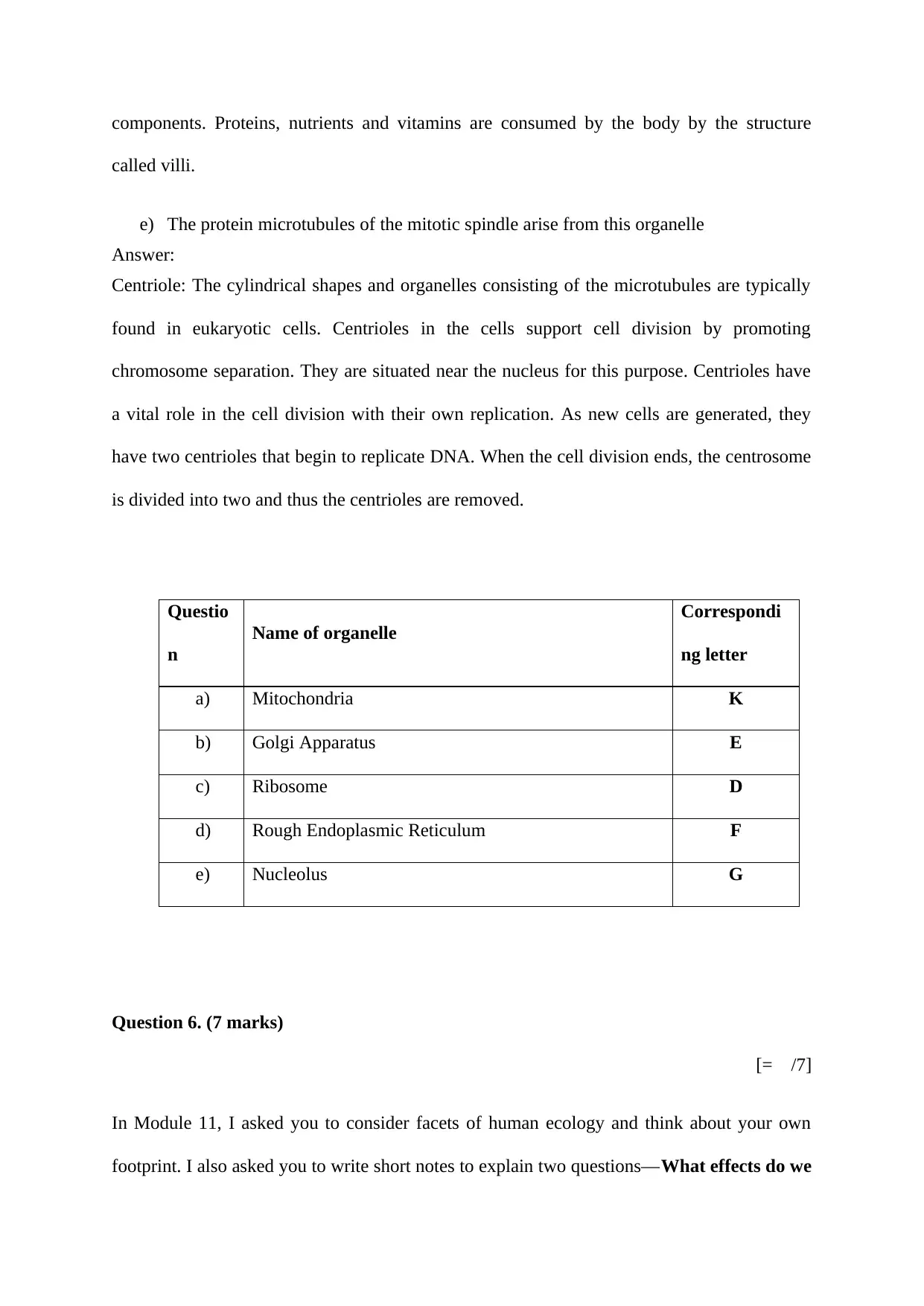
components. Proteins, nutrients and vitamins are consumed by the body by the structure
called villi.
e) The protein microtubules of the mitotic spindle arise from this organelle
Answer:
Centriole: The cylindrical shapes and organelles consisting of the microtubules are typically
found in eukaryotic cells. Centrioles in the cells support cell division by promoting
chromosome separation. They are situated near the nucleus for this purpose. Centrioles have
a vital role in the cell division with their own replication. As new cells are generated, they
have two centrioles that begin to replicate DNA. When the cell division ends, the centrosome
is divided into two and thus the centrioles are removed.
Questio
n
Name of organelle
Correspondi
ng letter
a) Mitochondria K
b) Golgi Apparatus E
c) Ribosome D
d) Rough Endoplasmic Reticulum F
e) Nucleolus G
Question 6. (7 marks)
[= /7]
In Module 11, I asked you to consider facets of human ecology and think about your own
footprint. I also asked you to write short notes to explain two questions—What effects do we
called villi.
e) The protein microtubules of the mitotic spindle arise from this organelle
Answer:
Centriole: The cylindrical shapes and organelles consisting of the microtubules are typically
found in eukaryotic cells. Centrioles in the cells support cell division by promoting
chromosome separation. They are situated near the nucleus for this purpose. Centrioles have
a vital role in the cell division with their own replication. As new cells are generated, they
have two centrioles that begin to replicate DNA. When the cell division ends, the centrosome
is divided into two and thus the centrioles are removed.
Questio
n
Name of organelle
Correspondi
ng letter
a) Mitochondria K
b) Golgi Apparatus E
c) Ribosome D
d) Rough Endoplasmic Reticulum F
e) Nucleolus G
Question 6. (7 marks)
[= /7]
In Module 11, I asked you to consider facets of human ecology and think about your own
footprint. I also asked you to write short notes to explain two questions—What effects do we
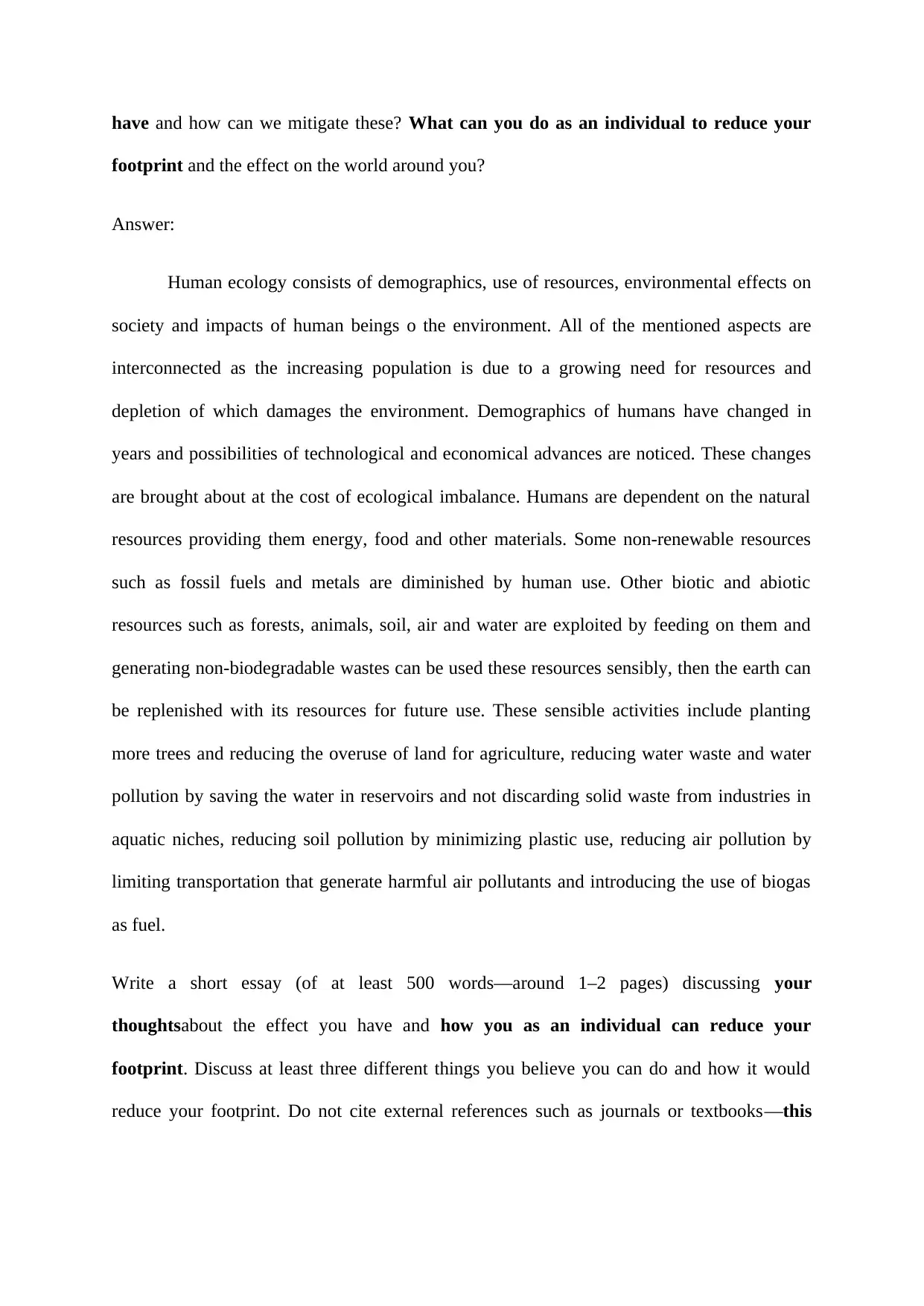
have and how can we mitigate these? What can you do as an individual to reduce your
footprint and the effect on the world around you?
Answer:
Human ecology consists of demographics, use of resources, environmental effects on
society and impacts of human beings o the environment. All of the mentioned aspects are
interconnected as the increasing population is due to a growing need for resources and
depletion of which damages the environment. Demographics of humans have changed in
years and possibilities of technological and economical advances are noticed. These changes
are brought about at the cost of ecological imbalance. Humans are dependent on the natural
resources providing them energy, food and other materials. Some non-renewable resources
such as fossil fuels and metals are diminished by human use. Other biotic and abiotic
resources such as forests, animals, soil, air and water are exploited by feeding on them and
generating non-biodegradable wastes can be used these resources sensibly, then the earth can
be replenished with its resources for future use. These sensible activities include planting
more trees and reducing the overuse of land for agriculture, reducing water waste and water
pollution by saving the water in reservoirs and not discarding solid waste from industries in
aquatic niches, reducing soil pollution by minimizing plastic use, reducing air pollution by
limiting transportation that generate harmful air pollutants and introducing the use of biogas
as fuel.
Write a short essay (of at least 500 words—around 1–2 pages) discussing your
thoughtsabout the effect you have and how you as an individual can reduce your
footprint. Discuss at least three different things you believe you can do and how it would
reduce your footprint. Do not cite external references such as journals or textbooks—this
footprint and the effect on the world around you?
Answer:
Human ecology consists of demographics, use of resources, environmental effects on
society and impacts of human beings o the environment. All of the mentioned aspects are
interconnected as the increasing population is due to a growing need for resources and
depletion of which damages the environment. Demographics of humans have changed in
years and possibilities of technological and economical advances are noticed. These changes
are brought about at the cost of ecological imbalance. Humans are dependent on the natural
resources providing them energy, food and other materials. Some non-renewable resources
such as fossil fuels and metals are diminished by human use. Other biotic and abiotic
resources such as forests, animals, soil, air and water are exploited by feeding on them and
generating non-biodegradable wastes can be used these resources sensibly, then the earth can
be replenished with its resources for future use. These sensible activities include planting
more trees and reducing the overuse of land for agriculture, reducing water waste and water
pollution by saving the water in reservoirs and not discarding solid waste from industries in
aquatic niches, reducing soil pollution by minimizing plastic use, reducing air pollution by
limiting transportation that generate harmful air pollutants and introducing the use of biogas
as fuel.
Write a short essay (of at least 500 words—around 1–2 pages) discussing your
thoughtsabout the effect you have and how you as an individual can reduce your
footprint. Discuss at least three different things you believe you can do and how it would
reduce your footprint. Do not cite external references such as journals or textbooks—this
⊘ This is a preview!⊘
Do you want full access?
Subscribe today to unlock all pages.

Trusted by 1+ million students worldwide
1 out of 16
Your All-in-One AI-Powered Toolkit for Academic Success.
+13062052269
info@desklib.com
Available 24*7 on WhatsApp / Email
![[object Object]](/_next/static/media/star-bottom.7253800d.svg)
Unlock your academic potential
Copyright © 2020–2025 A2Z Services. All Rights Reserved. Developed and managed by ZUCOL.